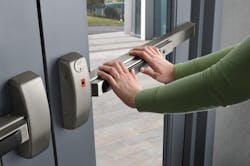When crowds gather indoors, most people tend to take their safety for granted. If you’ve been to 100 concerts without incident, why would you think the 101st would be any different? But in a panic or emergency situation, this is one of the toughest challenges for public safety officials. As fire marshals, police and other professionals are aware, when people panic, many things can go wrong as they run for the doors.
That’s why modern exit devices – those horizontal push bars on a door that most people never give a second thought to – are designed to operate without having to think about it.
And it’s not optional, it’s the law; buildings that can accommodate large numbers of people must be designed, constructed and maintained in a way that ensures that everyone inside can get out quickly and safely, even if they’ve never been in the building before.
In an emergency, people need to be able to open an exit door immediately without having to spend any time figuring out how it operates. An exit device provides single-motion egress – just push on it and it opens. That’s why the push pad of an exit device – the part that actuates the device – must be half the width of the door. Even if a crowd is in a panic and pushing against the exit door, the crush of the crowd against the push pad will cause it to release.
Code Requirements
The International Building Code® (IBC) is a model code developed by the International Code Council® (ICC) and revised every three years. The code is not mandatory until a state or local jurisdiction adopts it – at which point it becomes law.
In general, buildings and indoor areas where more than 50 people are permitted to assemble are required to be equipped with exit devices. The law requires them in assembly and educational occupancies.
Since building code adoption and enforcement varies across the country, if in doubt, consult with a professional specifications writer to ensure compliance with local regulations. The local Authority Having Jurisdiction (AHJ) has final judgment for the requirements related to any specific building or project.
A Delay Is A Good Thing
With delayed-egress exit devices, if someone pushes on the push bar, an alarm will sound and the device will not release for 15 seconds. These are applicable in certain situations; for example, a big-box retailer might need to have an emergency exit at the back of the store but doesn’t want someone to walk out with a TV. If they try to sneak through the door, the alarm will sound but the door will delay opening, giving security time to prevent the theft.
Delayed egress exit devices are allowed on doors serving any type of occupancy except assembly, educational and hazardous materials, but only when used in conjunction with an automatic sprinkler system. Upon activation of the sprinkler system, the delay function of the device is deactivated, allowing free and immediate egress.
Delayed egress devices are also used in places like stairwell access in hospitals and university dormitories and in hospital maternity wards, which require free egress but are also among the most secure areas of a hospital. In these cases, authorized personnel can use credentials like prox cards to override the exit device.
The 2015 edition of the International Building Code added provisions for delayed egress devices in places where Alzheimer’s and dementia patients are provided care. Where there is a chance someone might wander out of the facility, the 15-second delay will alert the staff. A delayed-egress exit device strikes a balance between letting people who can’t provide for their own safety slip out the door unnoticed, yet giving them immediate egress in the case of a fire or emergency.
Trial By Fire
Another important function of exit devices is to keep doors closed in the event of a fire to prevent backdraft and keep fire from spreading in a building, thus keeping people safe and protecting property.
Exit devices and doors can be certified as either fire-rated or non-fire-rated, depending on their construction. Fire rated doors and frames are required in certain locations in the building and are designed to withstand fire for a specific period of time. The exit devices installed on such doors also have to be fire-rated.
Underwriters Laboratories (UL) is the main regulatory authority that sets performance standards for exit devices, doors and frames. It’s no surprise that UL’s testing procedures are rigorous. UL builds a wall with a door frame, and mounts a steel door with the exit device to be tested. Then a furnace is started and flames attack the door and the exit device for three hours at a temperature of about 2,000 degrees. After the flames subside the door is hit with cold water from a fire hose to simulate a real-life scenario.
In order to pass the test, the latch has to stay latched. The entire device can melt off the door during the test – but the latch has to stay latched. This is what keeps people safe in the event of an actual fire. Those who are in a part of the building that is not burning have time to get out without a backdraft reaching them through an unlatched door. In the case of fire doors, different UL rating levels indicate how long a door will withstand a fire (20 minutes, 60 minutes and so on). The rating level required for an opening depends on its location and purpose as defined in the local building code. The National Fire Protection Association (NFPA) also provides guidelines regarding fire doors.
Even if a device passes UL’s testing, the safety assurance process doesn’t end there. UL-listed exit devices and other certified door hardware are often retested every one to three years. If a manufacturer makes any changes to a product it has to go back to UL and be retested. UL can also send field inspectors to a manufacturing facility and take a product right off the production line to inspect it and make sure it’s compliant. The manufacturer’s laboratory is also inspected once a year by a UL team that makes sure the lab’s equipment is calibrated and certified to National Institute of Standards and Technology requirements.
Exit devices must also comply with the Americans With Disabilities Act (ADA). The device must be installed at a certain height above the floor, and must be able to be opened without any twisting or pinching.
Built to Last
In addition to meeting UL standards, exit devices must also conform to the standards set by the Builders Hardware Manufacturers Association (BHMA) and the NFPA. The BHMA sets minimum standards for performance, such as opening force required and the number of cycles a device operates before failure. BHMA Grade 1, the association’s top rating, stipulates that a device has to withstand 500,000 cycles before it fails. However, consider if this is enough in light of real-world conditions. A device may actually have to last through tens of millions of cycles to last the lifetime of a building. For example, if the main entrance to a hospital is used an average of twice a minute, that’s over a million cycles a year.
To ensure that exit devices last the life of the building, architects and specifiers should make sure the product is BHMA-certified. Look for the BHMA-certified logo and listing in the online directory of BHMA-certified products. Exit devices that merely claim to be ANSI-compliant or are “designed to meet ANSI/BHMA standards” may not in fact be compliant.
Using BHMA Grade 1-certified exit devices has another advantage: they reduce the total cost of ownership of the door opening, thanks to their reduced maintenance and longer service life.
Beyond safety considerations, the choice of an exit device can be influenced by concerns about operational noise, and appearance. Exit devices that use motors rather than solenoids typically are quieter in operation, which is desirable in places like hospitals and dormitories. Solenoids tend to be loud. And appearance is almost always a concern – architects and designers want door hardware to look good and complement the rest of a building’s fittings and décor.
The good news is that the functionality, safety, durability and even appearance of exit devices have improved steadily over the years. Security professionals and building managers can be secure in the knowledge that when properly implemented, today’s exit devices are safer and more user friendly than ever.






